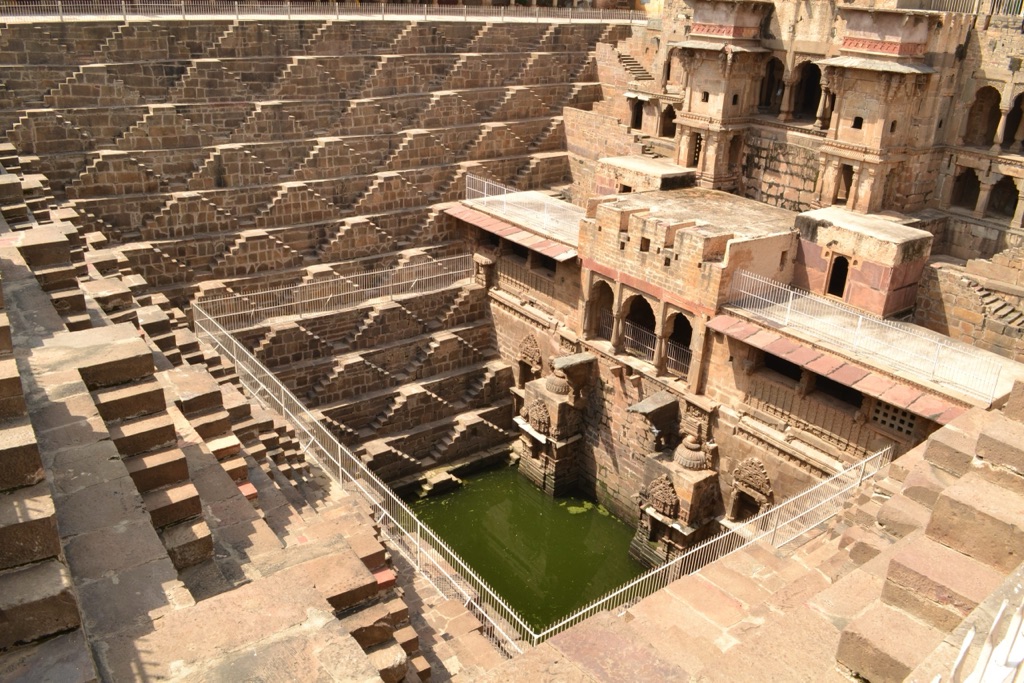The Chand Baori Step Well is a stunning example of ancient Indian architecture and design. Located in the village of Abhaneri near Jaipur in the Indian state of Rajasthan, it is one of the oldest and most attractive landmarks in the country. This stepwell is renowned for its intricate geometric design, consisting of 3,500 narrow steps descending 20 meters to the bottom of the well. It was built around the 8th and 9th centuries AD, serving not only as a water storage system but also as a gathering place for locals. The stepwell has gained international fame for its mesmerizing symmetry and engineering prowess.
Get your dose of History via Email
Historical Background of Chand Baori Step Well
Chand Baori Step Well dates back to the 8th-9th century AD. King Chanda of the Nikumbh dynasty, associated with the Gurjara-Pratihara clan, commissioned it. The well was designed to conserve as much water as possible. In a region like Rajasthan, known for its arid climate, such structures were vital for survival. The stepwell served as a gathering place for the community, a site for rituals, and a cool retreat during the scorching summers.
Its discovery by the western world is relatively recent, with travelers and historians bringing it to international attention in the 20th century. The stepwell’s architecture reflects the expertise of the era’s craftsmen. It has been maintained through the centuries, surviving the rise and fall of empires. The stepwell has seen various rulers and was even used by locals until recent times.
Chand Baori is not just a practical water storage system. It also holds a place of religious significance. The well is adjacent to the Harshat Mata Temple, suggesting that it was also a sacred site. The temple and stepwell together indicate the integration of utilitarian and spiritual design in ancient Indian architecture.
While not the scene of any major historical events, the stepwell is a testament to the daily lives of the people who built it and those who followed. It reflects the ingenuity of ancient societies in addressing environmental challenges. The stepwell’s design and construction techniques have inspired modern architects and engineers worldwide.
Chand Baori remains a source of fascination for historians and archaeologists. Its preservation allows for a glimpse into the past, offering insights into the social and technological advancements of the time. The stepwell continues to attract visitors, both for its historical value and its architectural beauty.
About Chand Baori Step Well
Chand Baori Step Well is a marvel of engineering and architecture. It is one of the largest stepwells in the world, with a depth of approximately 20 meters. The well comprises 13 levels and is lined with double flights of steps on three sides, which descend to a greenish pool at the bottom. The fourth side features a set of pavilions built on top of each other, with intricate carvings and jharokhas (overhanging enclosed balconies).
The stepwell was constructed using local materials, primarily hard volcanic stone, which has withstood the test of time. The stone was carved with precision, creating the mesmerizing patterns that line the well. The steps form a unique geometrical pattern when viewed from above, resembling a magical maze.
Architectural highlights include the ornate panels of gods and goddesses carved into the walls and niches. These carvings depict scenes from Hindu mythology, adding a spiritual dimension to the structure. The pavilions at the well’s edge showcase the artistic and architectural styles of the period, with strong influences from both Buddhist and Hindu traditions.
The method of construction reflects the advanced understanding of geometry and spatial arrangement of the time. The stepwell’s design also takes into account the earth’s movements, as it has remained structurally sound despite the region being prone to seismic activity.
Chand Baori is not only a testament to the ingenuity of ancient water conservation methods but also a masterpiece of aesthetic design. Its combination of functionality and beauty makes it a significant cultural and historical site, drawing admiration from around the globe.
Theories and Interpretations
Several theories surround the Chand Baori Step Well, particularly regarding its intended use. While primarily a water storage system, it likely served as a cool retreat during the hot summers. The stepwell’s design provided relief from the heat, as the temperature at the bottom is typically several degrees cooler than at the surface.
Some believe that the stepwell had a religious function, as evidenced by its proximity to the Harshat Mata Temple. It may have been used for ritualistic purposes, with the water considered sacred. The carvings of deities support this theory, suggesting a spiritual significance to the structure.
There are mysteries surrounding the exact methods and tools used for its construction. The precision of the stonework indicates a high level of skill and knowledge. However, the specific techniques remain a topic of research and speculation among historians and archaeologists.
Historical records do not provide a complete account of the stepwell’s construction. Therefore, much of its history has been pieced together through interpretations of its architecture and artifacts found on site. Dating of the structure has been carried out using architectural styles and inscriptions, which align with the 8th-9th century AD.
Despite its age, the stepwell’s condition has allowed for detailed study, providing valuable insights into the era’s engineering and social practices. The ongoing analysis and interpretation of Chand Baori help to fill in the gaps of India’s historical narrative.
At a glance
Country: India
Civilization: Gurjara-Pratihara dynasty, Nikumbh dynasty
Age: Approximately 1,200 years (8th-9th century AD)
Conclusion and Sources
Reputable sources used in the creation of this article include:
- Wikipedia – https://en.wikipedia.org/wiki/Chand_Baori
- Britannica – https://www.britannica.com/topic/stepwell

